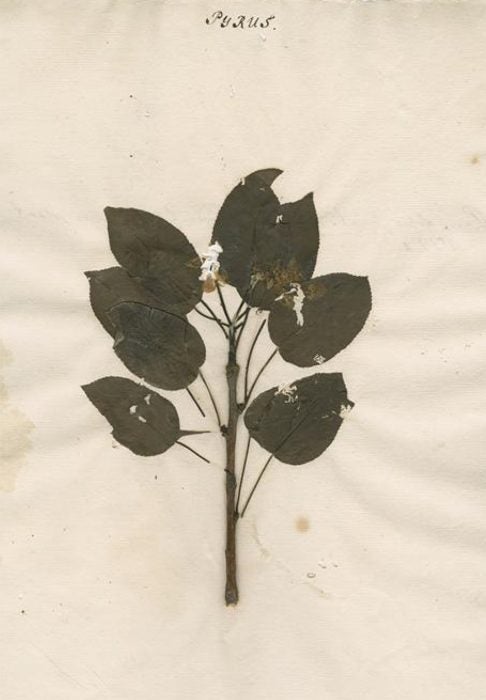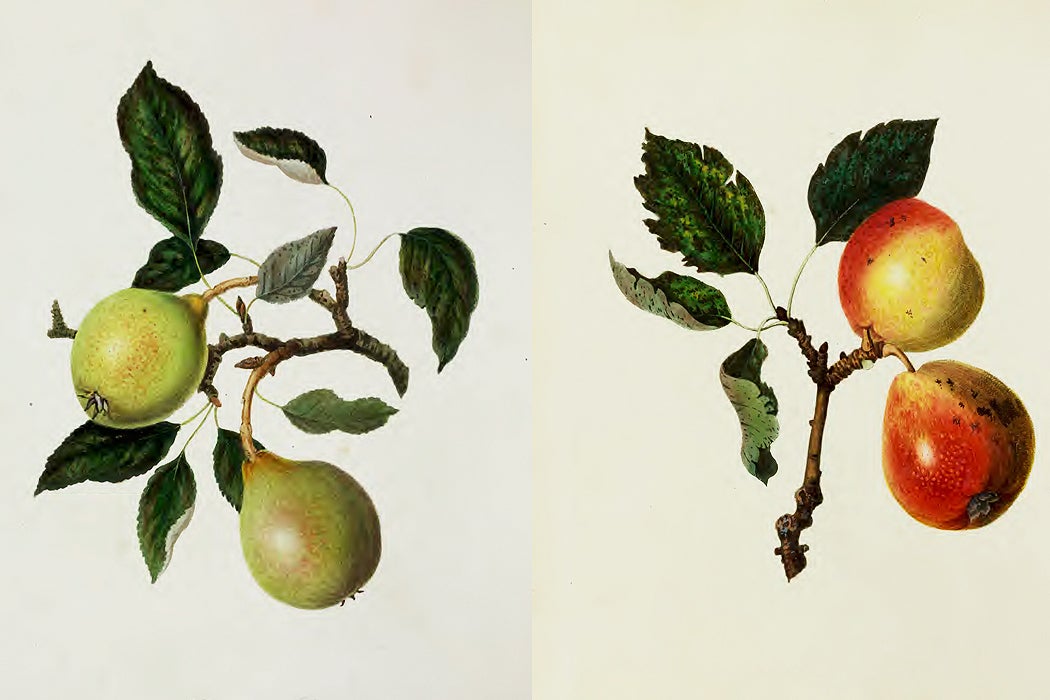People were drinking perry—a fermented drink with fine bubbles made of inedible pears—for at least 150 years before the legend of Dom Perignon chancing upon his liquid stars in the French region of Champagne. And yet, somewhere along the line we forgot about perry, and over a hundred varieties of ancient perry trees throughout England’s West Midlands sunk into oblivion. That they were found again is partly due to the beautiful and accurate drawings of nineteenth-century botanical artists.
The Three Counties, referring to the agrarian West Midlands counties of Herefordshire, Gloucestershire, and Worcestershire, are unique in having more than a hundred varieties of inedible pear. Rather than let the tannin-rich fruit go to waste, by the 1500s agricultural families across the West Midlands (and bordering eastern Wales) were making and drinking perry. According to tradition, as the wonderfully-named Cherry Ripe writes in Gastronomica, a perry orchard should contain several varieties. This makes the harvest more manageable by spreading it across late autumn. It also staggers the flowering, which in turn staggers the risk of frost damage, and allows for unique flavour blending. But in order to do this, you have to be able to identify several varieties. By the 1800s, botanical artists specializing in fruit were drawing them all.
The nineteenth century has been called the golden age of illustrated pomological (from the Latin word for fruit pomum) books. Books like T. A. Knight’s Pomona Herefordiensis (1811), George Brookshaw’s Pomona Britannica (1822), and R. Hogg and H. G. Bull’s Herefordshire Pomona (1876-85) are beautiful records of England’s pomological history. Behind these books’ illustrations were meticulous pomological artists such as Francis Bauer, Alice Blanche Ellis, Edith Bull and William Hooker (who was also a horticulturalist of repute).
Perry fell out of fashion in the twentieth century. Orchards were increasingly neglected and the names of the varieties forgotten. Then, in the 1960s a Somerset brewer called Francis Showering invented Babycham. It wasn’t really perry—it was a sugary, sparkling drink made of Somerset dessert pears—but it was a reminder of the old perry and so popular that in 1970 the British government put an excise tax on perry and cider making. According to Ripe, the now less lucrative orchards were ripped up and the land put to other use. After all, since perry pears are too astringent to be eaten (the Flaky Bark variety will actually burn the inside of your mouth), their monetary value was linked to perry. Whether driven by childhood memories of drinking perry with dinner or the vision of a marketing opportunity, by the late 1970s a nostalgic few like Gloucestershire cheesemaker Charles Martell began combing the West Midlands for perry trees, talking to ageing farmers and consulting old references.

The search for old references was greatly helped in the 1980s by two retired horticulturalists. William T. Stearn and Frederick Roach OBE were eminent scholars with illustrious backgrounds and publications. Their 1989 joint effort, Hooker’s finest fruits: a selection of paintings of fruits by William Hooker (1779-1832), was a rediscovery of the above-mentioned William Hooker’s meticulously illustrated early ninteenth century pomological work. According to R. G. C. Desmond, historian and former librarian of the Royal Botanic Gardens at Kew, it brought “to public attention for the first time…fruit varieties that have almost vanished.”
We now know that at least one hundred perry pear varieties are still extant. As Ripe notes, they often have evocative names like Late Treacle, Merrylegs, Mumblehead, Lumberskull, Huffcap, Longford, and Stinking Bishop, which Charles Martell now uses to wash one of his cheeses. With perry production protected in Gloucestershire, Herefordshire, and Worcestershire since 1996 (European Union Protected Geographical Indication status), perry pear orchards are once again thriving in the West Midlands. New perry trees don’t reach maturity for about thirty years, but since the trees are productive for more than 200 years, revived old orchards are once again producing perry.
There is a saying in the West Midlands: Plant Pears for your Heirs. We could also quite rightly say, “Paint pears for your Heirs!” Thanks to botanical artists, nineteenth-century paintings of perry pears are helping to bring England’s forgotten bubbly back to our glasses.
SaveSave







